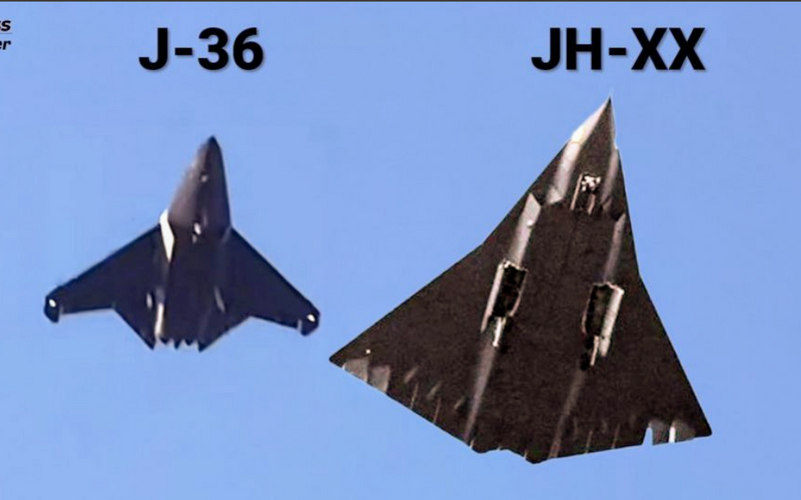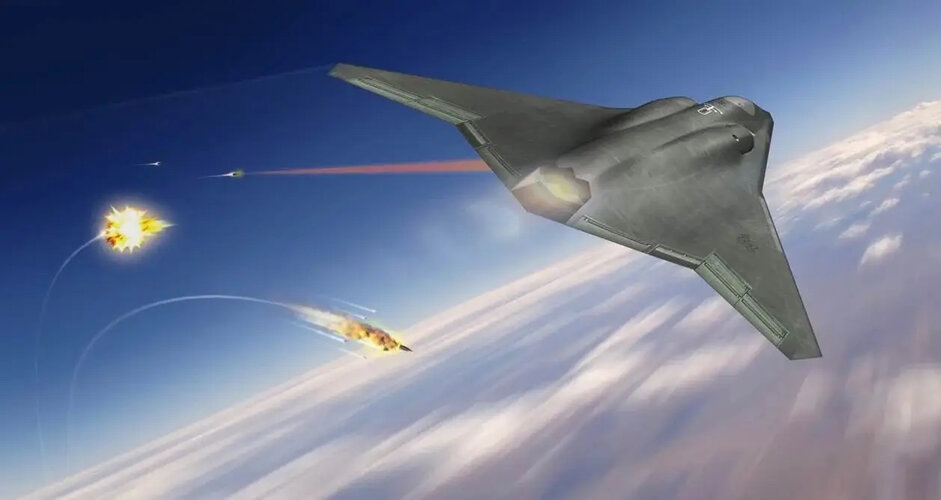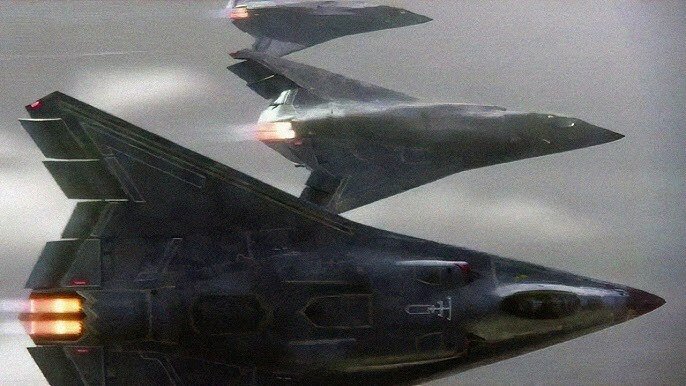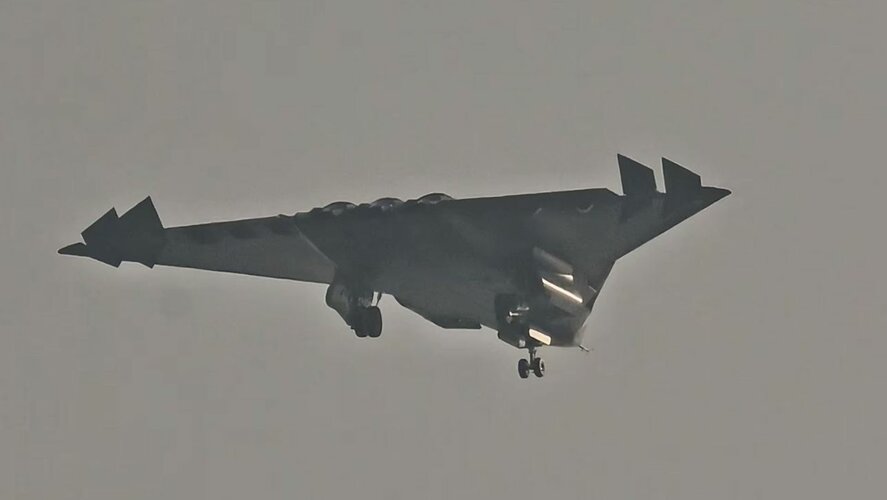Are you saying this to say this, or have you actually been following patents and research done by the Chinese aviation Industry. The language and internet barrier makes it even harder to follow Chinese developments, but It doesn't mean you can't find anything. Your comments just seem like a way of downplaying anything coming out of China. There are dozens of interesting concepts and patents coming out from China, it just seems you haven't actually tried looking for them.I think this picture describes every user here and on other forums of China claiming it has a 6th generation aircraft.
View attachment 753945
Claims of Quantum radars and laser sensing satellites detecting submarines killed the hype of their own 6th gen aircraft. They have not offered outside of the box thinking in any aviation achievements from patents, avionics and missile breakthroughs, engine breakthrough performances, etc.
Engines: China has no dates on estimated production or development for adaptive cycle engines or detonation engines. Usually, the performance of engines determines what kind of aerodynamic layout you would have planned for a new aircraft. Using foreign engines on your 5th generation aircrafts not too long ago to immediately designing what the physical layout would look like for a new generation aircraft just seems too early and set for compromises in combat in case actual 6th gen aircraft engines come out that would make you question if you should have done a different physical layout than the one you did before with underperforming engines.
Patents: US did serpentine ducts, flat nozzle, round serrated nozzle designs. Russia did partial S-ducts with radar blockers for performance, switching from round nozzles to serrated round nozzle, to round flat nozzles, removed horizontal stabilizers on the Su-75 and made the aircraft configurable to be one seat, two seat, or AI by changing cockpits. What did China even do that showed some kind of creativity in aviation that made them look different or standout?
Electronics: Of course, they have come a long way to producing smaller wafers with high yield production overcoming western sanctions. However, the U.S. will still have the edge in radars because of using Taiwan or Japan's electronics production for their own 6th gen aircrafts. And Russia started production a month ago in PICs and have their own photonic computer set to be made to operate in Zettaflops which will match Intel and Japan's supercomputer plan's for the same Zettaflop range in like 2030 which is insane because Russia's domestic electronic wafer production capabilities are at 300nm to 90nm when they made those claims and eventually they will get to smaller size production capabilities to 11nm to improve their PICs https://www.notebookcheck.net/Russi...stem-to-rival-ASML-s-technology.935627.0.html.
Even Intel is changing its direction to photonics and a lot of investors in the US are looking into this direction as well. PICs also enhance neural network and A.I. capabilities. I am pretty damn sure China's 6th gen aircraft AFAIK is not flying around with PICs and a photonic computer.
Missiles: RVV-MD2 is basically the same as AIM-9x Block 3 with the 50-60km short missile range and 360-degree LOAL engagement. Both US and Russa are designing internal 300km air to air missiles and internal hypersonic air to ground missiles. Anything like that from China has been announced? I think ramjet air to air missile designs will be the future for same high speeds but longer ranges and 2030+ we will see production of these kinds of missiles for any 6th gen aircraft.
What makes any news from China feel so disinteresting like 6th gen aircrafts is that it feels like a copy and paste from another country's kind of aviation achievements such as the US. The UK and China immediately trying to field 6th gens while the US and Russia are taking their sweet ass time tells me whose latest aircraft designs would have more defining features what makes a 6th gen aircraft a 6th gen aircraft. This doesn't mean I will completely go shit on the Tempest and J-36 but that my current expectations are set very low unless they go with upgrades later on them.
You are using an out of date browser. It may not display this or other websites correctly.
You should upgrade or use an alternative browser.
You should upgrade or use an alternative browser.
Shenyang / Chengdu "6th Gen" Aircraft - News and Analysis
- Thread starter tequilashooter
- Start date
F-14ATomcat
ACCESS: Secret
- Joined
- 26 May 2024
- Messages
- 480
- Reaction score
- 915
it is a very old aircraft, I said modernNimrod regularly shut down engines for loiter. And fuel use is precisely the reason you'd want to do it.
KHambsch
ACCESS: Confidential
- Joined
- 11 May 2020
- Messages
- 180
- Reaction score
- 189
I believe it is being referred to as the J-36.Based upon the configuration of this platform, seems definitely geared towards the medium to low altitude strike missions and I could be wrong. I'm sure it has healthy supersonic dash speed performance as well. I don't think this thing has fighter-type maneuverability also, leave that to the second released platform, the J-20 and the J-35. It will be interesting how we (the US) will respond, I'm sure our intelligence organizations are working overtime or maybe the priority is getting Biden some more potato salad?
Japanese P-1 can also shut down two engines during cruise. While a very different use case it can and is still done.it is a very old aircraft, I said modern
- Joined
- 11 February 2007
- Messages
- 2,595
- Reaction score
- 4,439
*applause*!conceptually it's archeology, not engineering.
KHambsch
ACCESS: Confidential
- Joined
- 11 May 2020
- Messages
- 180
- Reaction score
- 189
Folks in the press are dubbing these two birds as thus:Japanese P-1 can also shut down two engines during cruise. While a very different use case it can and is still done.
Attachments
KHambsch
ACCESS: Confidential
- Joined
- 11 May 2020
- Messages
- 180
- Reaction score
- 189
"Analyst's" are suggesting the large diamond delta is an immediate range bomber.Folks in the press are dubbing these two birds as thus:
Last edited by a moderator:
- Joined
- 11 February 2007
- Messages
- 2,595
- Reaction score
- 4,439
If the Tories hadn't axed MRA.4 the Nimrod fleet would be newer than any F-22....it is a very old aircraft, I said modern
And pilots would still be shutting down a couple of engines to loiter.
Folks in the press are dubbing these two birds as thus:
Well, folks in the press are wrong to say that lol.
I can sort of understand why they might call CAC's bird as "JH-XX", but calling SAC's bird as "J-36" is just hilarious.
I wonder if they know that the designation J-36 emerged because on CAC's bird we see "36011", see below image) as the airframe number on its nose, and it is why CAC's bird is being called J-36. I mean, the utter incompetence of it.
=======
Even calling CAC's J-36 as "JH-XX" somewhat betrays a lack of imagination, as well as a deference to US DoD reports that have mentioned "JH-XX" whereas really in the last two years they should've already been sounding the alarm bells for PLA next gen/6th gen fighter efforts.
It's been 14 years since J-20 s/n 2001 flew, and somehow defense commentators and pundits are still making the same mistakes. If they just approached it with a bit of humility and actually listened to the PLA watching community for a while, they'd be able to bypass the years of inevitable consternation that's going to emerge.
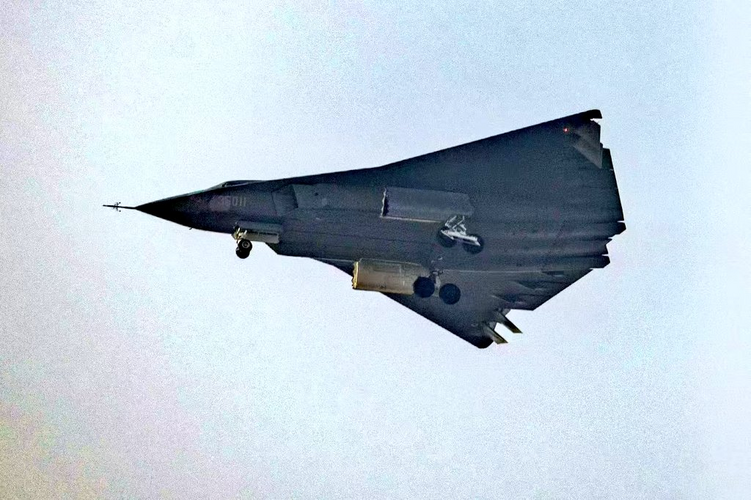
Perhaps they are trying to minimize trim drag as much as possible across a broad speed range.
Or redundancy/fault-isolation? With these being the only aerodynamic controls the aircraft has and it depending on artificial stabilization about all axes, it may be prudent to build in a bit of defence in depth, as it were. That way, if a control surface gets damaged a higher degree of control is retained, and if one actuator suffers a hard-over, the other surfaces can still overpower it.
Last edited:
FlyGuy369
Flying is fantastic
- Joined
- 15 June 2023
- Messages
- 257
- Reaction score
- 701
You know, I feel like I've seen this concept in play somewhere... Perhaps NG knows why they did it.Or redundancy/fault-isolation? With these being the only aerodynamic controls the aircraft has and it depending on artificial stabilization about all axes, it may be prudent to build in a bit of defence in depth, as it were. That way, if a control surface gets damaged a higher degree of control is ensured, and if one actuator suffers a hard-over, the others can still overpower it.
Attachments
snne
ACCESS: Top Secret
- Joined
- 3 July 2022
- Messages
- 1,405
- Reaction score
- 4,579
Even calling CAC's J-36 as "JH-XX" somewhat betrays a lack of imagination, as well as a deference to US DoD reports that have mentioned "JH-XX" whereas really in the last two years they should've already been sounding the alarm bells for PLA next gen/6th gen fighter efforts.
It's been 14 years since J-20 s/n 2001 flew, and somehow defense commentators and pundits are still making the same mistakes. If they just approached it with a bit of humility and actually listened to the PLA watching community for a while, they'd be able to bypass the years of inevitable consternation that's going to emerge.
View attachment 753966

FlyGuy369
Flying is fantastic
- Joined
- 15 June 2023
- Messages
- 257
- Reaction score
- 701
Here is a patent from CAC that describes a multi-control surface planform. It mentions the benefits of doing so too. Enjoy!
CN113184166A - Stability augmentation control method for flying wing layout unmanned aerial vehicle - Google Patents
The invention relates to the technical field of unmanned aerial vehicle flying wing layout, in particular to a method for controlling stability augmentation of an unmanned aerial vehicle with flying wing layout, which comprises the steps of arranging eight control surfaces on two wings of the...
patents.google.com
F-14ATomcat
ACCESS: Secret
- Joined
- 26 May 2024
- Messages
- 480
- Reaction score
- 915
Here is a patent from CAC that describes a multi-control surface planform. It mentions the benefits of doing so too. Enjoy!
CN113184166A - Stability augmentation control method for flying wing layout unmanned aerial vehicle - Google Patents
The invention relates to the technical field of unmanned aerial vehicle flying wing layout, in particular to a method for controlling stability augmentation of an unmanned aerial vehicle with flying wing layout, which comprises the steps of arranging eight control surfaces on two wings of the...patents.google.com
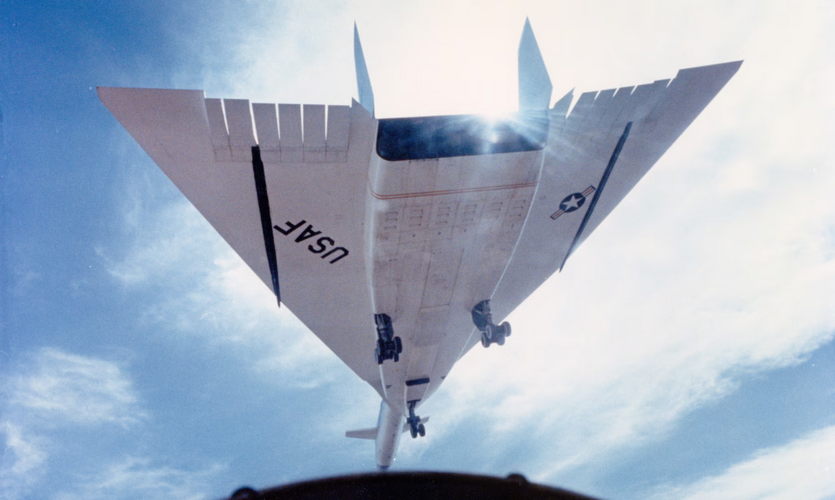
uhmmmm, B-70 used that configuration long long time ago
FlyGuy369
Flying is fantastic
- Joined
- 15 June 2023
- Messages
- 257
- Reaction score
- 701
Yes but there's a reason the US did it, and the reason they did it, that patent is filed under CACView attachment 753981
uhmmmm, B-70 used that configuration long long time ago
In_A_Dream
ACCESS: Top Secret
- Joined
- 3 June 2019
- Messages
- 675
- Reaction score
- 691
Ukraine is also a good reminder that dedicated platforms are insufficient compared to more platforms having some capacity. AFAIK only the PLAN, RAAF, and USN operate dedicated tactical jamming platforms. Perhaps some EU air forces get an ECR Typhoon. But F-35 is already an ECR/SEAD platform out of the box, and I cannot imagine anyone creates dedicated jammers in the future if the trend is large fighter/bombers with plenty of power and surface area for EW. I think the Growler and its J-15 equivalent are the last of their kind, at least for the top tier.
Well the truth is, there really hasn't been a pressing need for dedicated EW for quite some time, which is why the US has (admittedly) let it fall to the wayside, focusing instead on integrating supplemental capabilities into platforms like the F-35 and B-21. But that’s no substitute for dedicated EW in a heavily contested environment, where range, power, and role specialization are needed to overcome advanced threats (think battering ram).
Earlier this year, the US expressed interest in developing dedicated ‘spectral dominance platforms,’ so we’ll see what that manifests into. As for China, given their learning curve, I could see them developing a manned EW platform as a stepping stone toward more integrated air operations.
Time will tell
Last edited:
Based upon the configuration of this platform, seems definitely geared towards the medium to low altitude strike missions and I could be wrong. I'm sure it has healthy supersonic dash speed performance as well. I don't think this thing has fighter-type maneuverability also, leave that to the second released platform, the J-20 and the J-35. It will be interesting how we (the US) will respond, I'm sure our intelligence organizations are working overtime or maybe the priority is getting Biden some more potato salad?
US intelligence predicted a platform roughly like this years ago and presidents rarely have direct influence on DoD decisions and little influence on the purse.
If manned NGAD dies under the Trump administration, presumably you will blame it on the Diet Coke button?
Last edited:
- Joined
- 6 August 2007
- Messages
- 3,904
- Reaction score
- 6,041
Well the truth is, there really hasn't been a pressing need for dedicated EW for quite some time, which is why the US has (admittedly) let it fall to the wayside
No, Penetrating Electronic Attack is still very much a thing, and just as there is an Air Dominance 2030 “flight plan” there is an EW 2030 flight plan. There are dedicated electronic attack platforms in the pipeline.
In_A_Dream
ACCESS: Top Secret
- Joined
- 3 June 2019
- Messages
- 675
- Reaction score
- 691
Wonderful!No, Penetrating Electronic Attack is still very much a thing, and just as there is an Air Dominance 2030 “flight plan” there is an EW 2030 flight plan. There are dedicated electronic attack platforms in the pipeline.
Scott Kenny
ACCESS: USAP
- Joined
- 15 May 2023
- Messages
- 11,737
- Reaction score
- 14,524
Jeez this thread moves fast...
Unfortunately.
Civilian jetliners were able to go to twin engines due to engine reliability improvements, while before it was common to have to shut down one or more engines in flight. On the 747, losing one engine is not even considered an emergency situation!
That does seem to check with their behavior.I read an interesting piece on the Chinese approach to international law a month or so back (I forget where, unfortunately) that said they treat it not as something to be honoured, but as something to be pushed against until forced to stop.
Unfortunately.
Hrm. Interesting. Those will actually give pretty decent view straight ahead, which was my major concern. And having two means you can use triangulation for rangefinding if your sensors are sensitive enough.And there are two massive windows for them on the cheeks. In fact a small aperture like those on F-35 and J-20 was deemed inadequate that they added two very large windows.
Do not compare civilian jetliners with 3 engines to military aircraft.The best is a more efficient engine not adding one and carrying it as dead weight.
In example Mirage Balzac V versus harrier, or Yak-141 versus F-35B.
carrying extra engines shows engine inefficiency.
Add 3 engines increase cross section thus you add extra drag, if the Americans have better engines I doubt they will use 3 engines.
Tristar L1011 vs A-300 showed twin engines are better than 3, because they reduce problems.
Drag is one of them.
To early to say until i see the american or European 6th generation aircraft, but 3 engines are to be used otherwise are a waste of fuel and lack of space, this is contradictory since more space means more volume and more volume translates in weight.
This aircraft unveiling shows more a propaganda stunt than real capacity specially if western aircraft are planned with 2 engines
Civilian jetliners were able to go to twin engines due to engine reliability improvements, while before it was common to have to shut down one or more engines in flight. On the 747, losing one engine is not even considered an emergency situation!
2 larger engines have 2/3rds the maintenance of 3 smaller engines.Well, one needs similar levels of airflow for two large engines as one needs for three small engines - correct? One might have more duct losses due to higher surface area, but it might also be structurally easier to use three smaller ducts rather than two larger ones?
I always saw the decision to go with two engines as a way of reducing engine manufacturing and maintenance costs - but there isn't really anything two large engines can do that three engines 2/3rds their size cannot.
That would not surprise me.As for engines, I had thought perhaps the odd arrangement was an attempt to duplicate adaptive engine capabilities in a shorter timeframe, but the posts here have convinced me three of the same type simply for desired performance is more likely. That might not preclude a loiter mode with one shut down.
Either way, the implication to me is that an off the shelf engine design (or designs) is used to shorten development. The B-21 took a similar route. This makes me wonder if the entire Boxer project was not similar to the B-21s approach of only using tech readiness level 6 or above.
Two sensors means you can triangulate to get range to target passively.Thanks Nx4eu, it is rather strange to see them on the sides and having twin EOTS instead of the single EOTS sensor like on the J-20 but I suppose that there must have been a reason for the change since having the J-20 flying operationally.
Disagree, I just think that they're the last manned EW planes. A relatively small LO airframe with a ~3000lb thrust engine can play stand-in jammer/Penetrating EW even more effectively than a Growler or even a monster like an EC-135 or B-52 from stand-off ranges.Ukraine is also a good reminder that dedicated platforms are insufficient compared to more platforms having some capacity. AFAIK only the PLAN, RAAF, and USN operate dedicated tactical jamming platforms. Perhaps some EU air forces get an ECR Typhoon. But F-35 is already an ECR/SEAD platform out of the box, and I cannot imagine anyone creates dedicated jammers in the future if the trend is large fighter/bombers with plenty of power and surface area for EW. I think the Growler and its J-15 equivalent are the last of their kind, at least for the top tier.
radar-transparent paints are a thing.On the strictly minor side of things, I find it interesting the aircraft serial is painted over the cheek arrays.
That's certainly my initial suspicion. Plus, minimal trim drag also means minimum control surface movement and minimal changes to OML/RCS.Perhaps they are trying to minimize trim drag as much as possible across a broad speed range.
Wasn't the Tories that killed MRA.4, it was the lack of any living engineers that could design a cabled flight control system from scratch.If the Tories hadn't axed MRA.4 the Nimrod fleet would be newer than any F-22....
And pilots would still be shutting down a couple of engines to loiter.
- Joined
- 28 January 2008
- Messages
- 1,024
- Reaction score
- 2,227
We'll see what happens during Trump's second term but I can tell you this, our country was in a bad place, needs to be fixed and I hope it gets better. Maybe our US intelligence predicted these Chinese platforms and maybe not but maybe we had to create and build up this adversary just to build up US resolve again, think about it. I hope our B-21, USAF NGAD, USN F/A-XX materialize going forward.US intelligence predicted a platform roughly like this years ago and presidents rarely have direct influence on DoD decisions and CB little influence on the purse.
If manned NGAD dies under the Trump administration, presumably you will blame it on the Diet Coke button?
Last edited by a moderator:
red admiral
ACCESS: Top Secret
- Joined
- 16 September 2006
- Messages
- 1,818
- Reaction score
- 2,409
Probably a bit of that. Also gives easier FCS design so you can isolate different control surfaces to control different axes rather than more complex NDI mixing. Possibly this if the outer split controls are yaw only. I'd also wonder whether they just reused the same actuators as J-20 but then need to pair these with a smaller surface to get an acceptable hinge moment.Or redundancy/fault-isolation? With these being the only aerodynamic controls the aircraft has and it depending on artificial stabilization about all axes, it may be prudent to build in a bit of defence in depth, as it were. That way, if a control surface gets damaged a higher degree of control is retained, and if one actuator suffers a hard-over, the other surfaces can still overpower it.
Null
ACCESS: Confidential
- Joined
- 16 December 2024
- Messages
- 79
- Reaction score
- 124
My selective vision is telling me that I don't think Ukraine offers seekers with + or - 180 degrees target capture when launched, here is an export version of it which I am assuming the domestic version of it would be better.RVV-MD2 is a warmed over R-73 from the 1970s. Russia spend the 1990s trying to regain the ability to make R-73s, and then lost access to the (Ukrainian) seekers after the first Ukraine war in 2014 and had to sort that out by getting replacement seekers designed and made in Russia. It is now improving elements of the design, but conceptually it's archeology, not engineering.
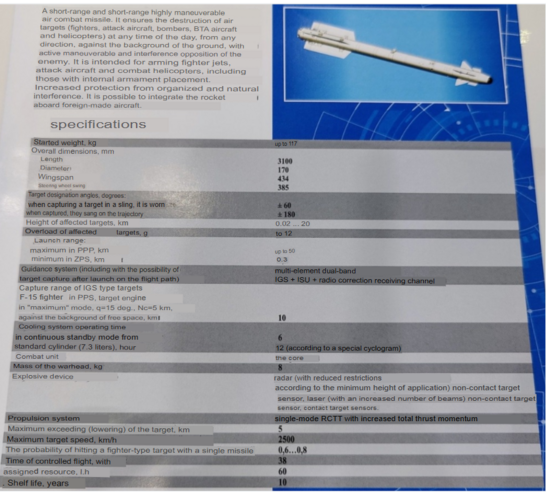

Russian RVV-MD2 air-to-air missile designed for Su-57 Felon dislayed a
google_ad_client = "pub-4068738923530102"; /* top_468x60_fiche_technique */ google_ad_slot = "2746785843"; google_ad_width = 468; google_ad_hei
Looking at the R-73 thread on this forum, I don't even think this brochure is posted there. So, do the Chinese have some kind of missile with LOAL capabilities excluding the US and Russia that can target aircrafts behind them when launched?In an interview with EDR On-Line, officials from the Russian state arms export agency Rosoboronexport asserted that American counterparts to the RVV-MD2 missile are lagging behind Russian-designed missiles by a margin of five to ten years. Viktor Murakhovsky, the editor-in-chief of the Russian defense magazine Arsenal Otechestva, explained that the RVV-MD2 is the first short-range missile to employ an inertial control system, which serves to stabilize and guide the missile during its autonomous flight. According to Murakhovsky, this missile is capable of striking targets from various angles, particularly from the rear hemisphere. In simple terms, the RVV-MD2 is launched forward, undergoes mid-air rotation, and targets an enemy aircraft that may be concealed behind the Su-57.
20kms on range seems like bad performance, can these missiles even target aircrafts behind them?China mastered production of the Python AAM as PL-8A in the the 1990s, in the 2000s improved it as PL-8B and have designed and in the 2010s designed and deployed the PL-10. General assessments are that PL-10 matches the current western AAMs like ASRAAM, IRIS-T and AIM-9X in performance. They now are designing a replacement for the PL-10.
PL-15, PL-16, PL-17 and PL-21 where do I even start here (way too many sources give guesstimates on ranges for Chinese missiles)? Its already going to be a pain in the ass to estimate missile technology because China and the US want to go 6 meters long and Russia wants to stay at 4 meters long with their BVR missiles. 1st I have a PL-21 source reference "could have" more than 3 times the range if they switched to a ramjet version of the PL-15. Some sources are unsure if PL-21 and PL-17 are the same they are either referenced at 6 meters + in length wherever you look at.China has deployed a number of longer range BVR AAMs and has been working on ramjet AAMs. Their progress is hypersonics has been noted.
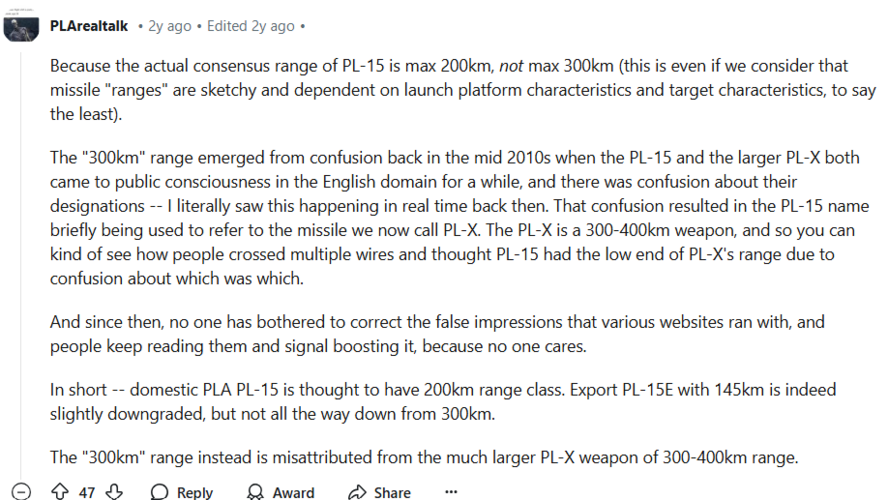
PL-17 is thrown at 300-400kms in range with a 6 meter length and 300mm diameter. https://www.reuters.com/world/us-na...ould-tilt-balance-south-china-sea-2024-08-14/ AIM-174B is 340mm diameter in 6 meter length with a 400km+ estimate. K-37M depending on where you look at reference 300kms from missile tests conducted in the 1990s and some estimate from 2014 sources that it got upgraded to 400kms. 4.06-4.2 meters in length and 380mm in diameter.
Now for internal carry long range missiles.

СÑ-57 ÑкоÑо полÑÑÐ¸Ñ ÑакеÑÑ Ð´Ð°Ð»ÑноÑÑÑÑ 300 киломеÑÑов
РоÑÑийÑкий иÑÑÑебиÑÐµÐ»Ñ Ð¿ÑÑого Ð¿Ð¾ÐºÐ¾Ð»ÐµÐ½Ð¸Ñ Ð¡Ñ-57 ÑкоÑо полÑÑÐ¸Ñ ÑакеÑÑ, ÑпоÑобнÑе поÑажаÑÑ Ñели на ÑаÑÑÑоÑнии до 300 киломеÑÑов. Ðб ÑÑом ТÐСС ÑообÑил иÑÑоÑник в обоÑонно-пÑомÑÑленном...
PL-15 and JATM are thrown around at 200kms, K-77M was thrown at 193kms in some sources and that is not including the ramjet version of it that was getting tested in 2020 alongside it.Russia's fifth-generation Su-57 fighter will soon receive missiles capable of hitting targets up to 300 kilometers away. This was reported to TASS by a source in the military-industrial complex.
According to him, at present, the Su-57 in the zone of a special military operation (SVO) solves tasks with high quality. "Today, the fighter operates at a range of 120 kilometers, in the near future they are waiting for the arrival of aviation missiles for high-speed air targets at a range of up to 300 kilometers," the source said.
The definition of pacing threat can mean anything, do they have scramjet missiles that are operational like zircon or have tested miniature nuclear reactors powering missiles with flight tests? Are we talking about missile, drone and electronics production? I still don't see anything surprising that you see so far on this conversation of air to air missiles if that's what we are referring to as a pacing threat.China is the "pacing threat". Russia is a distant third at best.
Scott Kenny
ACCESS: USAP
- Joined
- 15 May 2023
- Messages
- 11,737
- Reaction score
- 14,524
I missed replying to this the first time around, even though I quoted it (where's the embarrassed emoji?)
You're still talking about a ~50% inlet area increase for the more powerful engines. That's not trivial!Adding inlets for a new engine would be a #$%, but "fixing" it by removing an engine and resizing the inlets would be comparatively easy. New inlets and a different aft fuselage plug. Were this scenario true, they already did the design work for a twin with more powerful engines. The difficult redesign work was to add the engine/inlet area.
Scott Kenny
ACCESS: USAP
- Joined
- 15 May 2023
- Messages
- 11,737
- Reaction score
- 14,524
The US demo'd that in the 1970s, wasn't seen as a worthwhile effort (probably because it would have let the F-4 almost equal the F-15), as the AIM-95 AGILE. 320deg FOV for the seeker.Looking at the R-73 thread on this forum, I don't even think this brochure is posted there. So, do the Chinese have some kind of missile with LOAL capabilities excluding the US and Russia that can target aircrafts behind them when launched?
Rhinocrates
ACCESS: Top Secret
- Joined
- 26 September 2006
- Messages
- 3,061
- Reaction score
- 7,817
Regarding the ongoing argument about the triple engines, the thing to keep in mind when you see a counter-intuitive configuration is not 'that's a bad idea' but 'someone thought that it was worth the tradeoffs for it to accomplish its mission, given their current capabilities - so what is that mission?' Someone crunched some numbers and got a result that they liked.
Minuses are complexity/maintenance, weight, bulk/volume, heat, drag. What plusses outweigh these?
Given that Chinese technology is apparently not up to producing the advanced variable-cycle engines that GE and P&W are struggling to develop, I lean towards the hypothesis that the central engine is a low-bypass turbofan or turbojet optimised for high-altitude, high-speed supercruise without afterburner or low-altitude dash with afterburner. The three operate as a system, combining capabilities or biases. The dorsal intake is not a problem because it won't be doing a lot of high-AOA manoeuvring in either regime.
Minuses are complexity/maintenance, weight, bulk/volume, heat, drag. What plusses outweigh these?
Given that Chinese technology is apparently not up to producing the advanced variable-cycle engines that GE and P&W are struggling to develop, I lean towards the hypothesis that the central engine is a low-bypass turbofan or turbojet optimised for high-altitude, high-speed supercruise without afterburner or low-altitude dash with afterburner. The three operate as a system, combining capabilities or biases. The dorsal intake is not a problem because it won't be doing a lot of high-AOA manoeuvring in either regime.
Last edited:
- Joined
- 11 February 2007
- Messages
- 2,595
- Reaction score
- 4,439
It was flying with a Eurofighter-derived FCS when axed. I wasn't on the project, still doing Eurofighter, but friends were.Wasn't the Tories that killed MRA.4, it was the lack of any living engineers that could design a cabled flight control system from scratch.
With regards to the actual purpose of the aircraft, 6th gen superfighter, theatre bomber, etc. Is thrust vectoring on the current aircraft? If so, I could believe that this was meant to be an aircraft to sweep the skies clean, as some have suggesting with the twitter post talking about the potential thrust of the aircraft, but if it doesn't then I'd lean more towards long range striker. Then again, this could just be the equivalent of an X-plane with the only intent of proving certain concepts and technologies.
Scott Kenny
ACCESS: USAP
- Joined
- 15 May 2023
- Messages
- 11,737
- Reaction score
- 14,524
Were the wings not using mechanical cables to move the flight controls, not actuators?It was flying with a Eurofighter-derived FCS when axed. I wasn't on the project, still doing Eurofighter, but friends were.
- Joined
- 11 February 2007
- Messages
- 2,595
- Reaction score
- 4,439
If you have LOAL ability at all, then being able to do 360 degree LOAL is simply an autopilot software fix.My selective vision is telling me that I don't think Ukraine offers seekers with + or - 180 degrees target capture when launched
So given that the middle exhaust looks identical to other two, does that imply anything with regards to middle engine being in some way different from outer engines?
Which types of different engines can still have the same exhaust, and which types are unlikely to be used, given this same engine exhaust?
- Joined
- 11 February 2007
- Messages
- 2,595
- Reaction score
- 4,439
I've just re-read pages 2 and 3 of the MRA.4 thread to remind myself what was done. Cable controls, Typhoon-derived SAS, killed by the Tory (technically ConDem) Austerity bandwagon, not for technical reasons.Were the wings not using mechanical cables to move the flight controls, not actuators?
Scott Kenny
ACCESS: USAP
- Joined
- 15 May 2023
- Messages
- 11,737
- Reaction score
- 14,524
As large as s/n 36011 is, I do not believe it is an X-plane equivalent to test concepts and technologies. Look at the X-29, X-31, and Boeing Bird of Prey, they're tiny. Somewhere around 1/3 the MTOW of an F-16, 1/2 the MTOW of a Gripen, and that's for the X-planes. The BBOP is half the MTOW of the X-planes!With regards to the actual purpose of the aircraft, 6th gen superfighter, theatre bomber, etc. Is thrust vectoring on the current aircraft? If so, I could believe that this was meant to be an aircraft to sweep the skies clean, as some have suggesting with the twitter post talking about the potential thrust of the aircraft, but if it doesn't then I'd lean more towards long range striker. Then again, this could just be the equivalent of an X-plane with the only intent of proving certain concepts and technologies.
Same size exhaust implies 3 of the same size engines, not 2 of one type and 1 of another. So this makes the center engine highly unlikely to be a higher-bypass "cruise" engine.So given that the middle exhaust looks identical to other two, does that imply anything with regards to middle engine being in some way different from outer engines?
Which types of different engines can still have the same exhaust, and which types are unlikely to be used, given this same engine exhaust?
As large as s/n 36011 is, I do not believe it is an X-plane equivalent to test concepts and technologies. Look at the X-29, X-31, and Boeing Bird of Prey, they're tiny. Somewhere around 1/3 the MTOW of an F-16, 1/2 the MTOW of a Gripen, and that's for the X-planes. The BBOP is half the MTOW of the X-planes!
I agree, it's a huge aircraft but the main point I wanted to make was:
1. Is this an aircraft meant as a pre-production prototype to test and validate the general design concept, fix and refine, then go into mass production? Or this an aircraft meant as a one-off, "here's what we can make" by the Chinese military aerospace industry to the Chinese military?
2. Are there thrust vectoring nozzles on this aircraft or the potential to be fitted for them at some point, as well as afterburner? From what I have read on this thread and others on other sites, people are torn between this being the ultimate A2A fighter versus a clean-sheet stealth strike bomber in the same idea of the Su-34.
I personally am torn on the subject, if you are going to put complex CARAT type lower intakes and then a DSI upper intake, why not just save yourself the trouble and go full DSI? Unless the two outer engines are meant for higher speed operation and the inner one for efficient cruising, why have 3 of the same engine? Judging by the exhausts, they are the same model.
- Joined
- 6 September 2006
- Messages
- 4,841
- Reaction score
- 9,490
The answer will lie in the PLAAF's doctrine and not with like-for-like comparisons with NGAD or other current Western programmes.
If this isn't a JH and really is a 'fighter' (I use that term loosely) then obviously something has happened in the PLAAF since the introduction of the J-20. Whether its lack of deep magazines or insufficient range or insufficient command capability which a two-seat J-20S can't solve. It's unlikely this aircraft is designed to operate alongside J-20, they are too similar in role given the likely distances, even assuming 'J-36' is a loiterer.
The smaller design could well be the CCA for this 'J-36', its not too small so its radius of action must be reasonably similar to the 'J-36' (assuming the latter spends a lot of time loitering on station but not as much time loitering before it commits its CCAs). It could well be that those large bays are not just for large AAMs, its feasible they might be for air-launched mini-UCAVs.
If all this is true - then yes the PLAAF have beaten NGAD, GCAP and SCAF to develop a full FCAS concept with actual hardware rather than Powerpoints and CGI. How well the Chinese version works in comparison to these is an open question - but even if the systems quality isn't as good they will be refining the concept a good 5-10 years before everyone else is outside of a simulator.
If this isn't a JH and really is a 'fighter' (I use that term loosely) then obviously something has happened in the PLAAF since the introduction of the J-20. Whether its lack of deep magazines or insufficient range or insufficient command capability which a two-seat J-20S can't solve. It's unlikely this aircraft is designed to operate alongside J-20, they are too similar in role given the likely distances, even assuming 'J-36' is a loiterer.
The smaller design could well be the CCA for this 'J-36', its not too small so its radius of action must be reasonably similar to the 'J-36' (assuming the latter spends a lot of time loitering on station but not as much time loitering before it commits its CCAs). It could well be that those large bays are not just for large AAMs, its feasible they might be for air-launched mini-UCAVs.
If all this is true - then yes the PLAAF have beaten NGAD, GCAP and SCAF to develop a full FCAS concept with actual hardware rather than Powerpoints and CGI. How well the Chinese version works in comparison to these is an open question - but even if the systems quality isn't as good they will be refining the concept a good 5-10 years before everyone else is outside of a simulator.
Similar threads
-
-
Shenyang FC-31 demonstrators / J-35 naval fighter / J-35A land-based version
- Started by Foxglove
- Replies: 1K
-
-
-
Chinese test of Fractional Orbital Bombardment System
- Started by Flyaway
- Replies: 100

